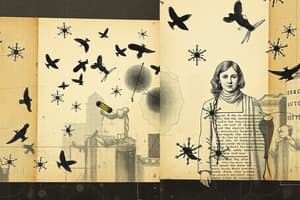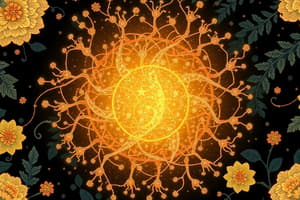Podcast
Questions and Answers
What type of resistance involves microorganisms that naturally resist the activity of some antimicrobials?
What type of resistance involves microorganisms that naturally resist the activity of some antimicrobials?
- Natural resistance (correct)
- Selective resistance
- Acquired resistance
- Adaptive resistance
Which mechanism allows microorganisms to destroy the active drug, thus developing resistance?
Which mechanism allows microorganisms to destroy the active drug, thus developing resistance?
- Altered permeability
- Enzyme production (correct)
- Efflux pumping
- Gene mutation
Which type of antibacterial agent inhibits cell wall synthesis?
Which type of antibacterial agent inhibits cell wall synthesis?
- B-lactams (correct)
- Tetracyclines
- Quinolones
- Aminoglycosides
What is a significant consequence of the indiscriminate use of antimicrobial agents?
What is a significant consequence of the indiscriminate use of antimicrobial agents?
Which of the following is NOT a mechanism by which acquired resistance can occur?
Which of the following is NOT a mechanism by which acquired resistance can occur?
What class of antibiotics includes penicillins and cephalosporins?
What class of antibiotics includes penicillins and cephalosporins?
Which of the following is an example of a non-Beta-lactam antibiotic?
Which of the following is an example of a non-Beta-lactam antibiotic?
How do Gram-negative bacteria develop resistance to aminoglycosides?
How do Gram-negative bacteria develop resistance to aminoglycosides?
Which classification of antimicrobial agents includes substances specifically used on living tissue?
Which classification of antimicrobial agents includes substances specifically used on living tissue?
What term refers to a chemical that kills bacteria?
What term refers to a chemical that kills bacteria?
Which of the following is an example of an antimicrobial agent obtained from fungi?
Which of the following is an example of an antimicrobial agent obtained from fungi?
What is meant by selective toxicity in the context of antimicrobial agents?
What is meant by selective toxicity in the context of antimicrobial agents?
Which type of antimicrobial agent is primarily used to cover a wide range of pathogens?
Which type of antimicrobial agent is primarily used to cover a wide range of pathogens?
Antimicrobial agents obtained by chemical synthesis are categorized under which type?
Antimicrobial agents obtained by chemical synthesis are categorized under which type?
Which statement accurately describes a bacteriostatic agent?
Which statement accurately describes a bacteriostatic agent?
What is the role of preservatives in antimicrobial agents?
What is the role of preservatives in antimicrobial agents?
Flashcards are hidden until you start studying
Study Notes
Antimicrobial Agents
- Chemical substances that kill or inhibit the growth of microorganisms.
- Subgroups: Antibacterials (antibiotics), antifungal, antiparasitic, and antiviral agents
- Obtained from microorganisms, synthesized in laboratories, or produced using recombinant DNA technology.
Types of Antimicrobial Agents:
- Based on Use:
- Internal and External: Antibiotics, antifungal, antiparasitic, and antiviral agents
- External Only: Antiseptics and disinfectants (kill or inhibit microorganisms on nonliving objects)
- Based on Source:
- Microorganisms:
- Fungi: Penicillins, cephalosporins
- Bacteria: Bacitracin, polymyxins, gentamicin
- Chemical Synthesis:Quinolones
- Semisynthesis: Part produced by fermentation, then further modified (e.g., amoxicillin, ampicillin)
- Microorganisms:
Important Terms:
- Bactericidal: Kills bacteria
- Bacteriostatic: Inhibits bacterial growth, reversible (growth resumes after removal)
- Antiseptics: Used on living tissue to kill or inhibit microorganisms
- Disinfectants: Used on nonliving objects to kill or inhibit microorganisms
- Preservatives: Extend storage life of products by inhibiting or destroying microorganisms
- Selective Toxicity: Affects microorganisms with minimal harm to human cells, measured by therapeutic index (toxic dose/therapeutic dose, must be greater than 3)
- Narrow Spectrum: Activity limited to specific groups of microorganisms (e.g., only Gram-positive or Gram-negative bacteria)
- Broad Spectrum: Covers a wide range of disease-causing microorganisms (e.g., active against both Gram-positive and Gram-negative bacteria)
Microbial Resistance
- Indiscriminate use leads to elimination of sensitive strains and replacement by resistant ones.
- Types:
- Natural (Intrinsic): Microorganisms inherently resist some antimicrobials (e.g., Mycoplasma lacks a cell wall, resists beta-lactam antibiotics)
- Acquired Resistance: Organisms were initially sensitive but became resistant. Mechanisms include:
- Enzymes that destroy the active drug:
- Staphylococci and Gram-negative bacteria resistant to penicillin G produce beta-lactamases
- Gram-negative bacteria resistant to aminoglycosides produce inactivating (adenylating) enzymes.
- Prevention of drug accumulation:
- Change in permeability: Microorganisms become impermeable to the drug (e.g., resistance to tetracycline and polymyxins)
- Active efflux by efflux pump: Removes the drug from the cell (e.g., resistance to tetracycline)
- Altered site of action:
- Some microorganisms resist aminoglycosides by altering or missing a protein on the 30S subunit of the ribosome, preventing drug attachment
- Altered metabolic pathway:
- Bypasses the reaction inhibited by the drug (e.g., some sulfonamide-resistant bacteria)
- Chromosomal mutation:
- Altered enzyme that performs its function unaffected by the drug (e.g., quinolone resistance due to mutations in the DNA gyrase gene)
- Enzymes that destroy the active drug:
Antibacterial Agents: Mechanisms of Action
- Inhibitors of cell wall synthesis
- Disruptors of cell membrane structure or function
- Inhibitors of protein synthesis
- Inhibitors of nucleic acid synthesis
- Inhibitors of metabolic pathways
Overview of Cell Wall Inhibitor Antibacterial Agents
- Beta-lactams:
- Penicillins
- Cephalosporins
- Monobactams
- Carbapenems
- Non-Beta-lactams:
- Glycopeptides
- Bacitracin
- Fosfomycins
B-Lactam Antibiotics
- Share a B-lactam ring structure (4-membered cyclic amide ring)
- Examples:
- Penicillins
- Cephalosporins
- Monobactams
- Carbapenems
- Mechanism of Action: Inhibit transpeptidases (enzymes involved in cell wall synthesis), preventing bacterial cell wall formation.
Studying That Suits You
Use AI to generate personalized quizzes and flashcards to suit your learning preferences.





